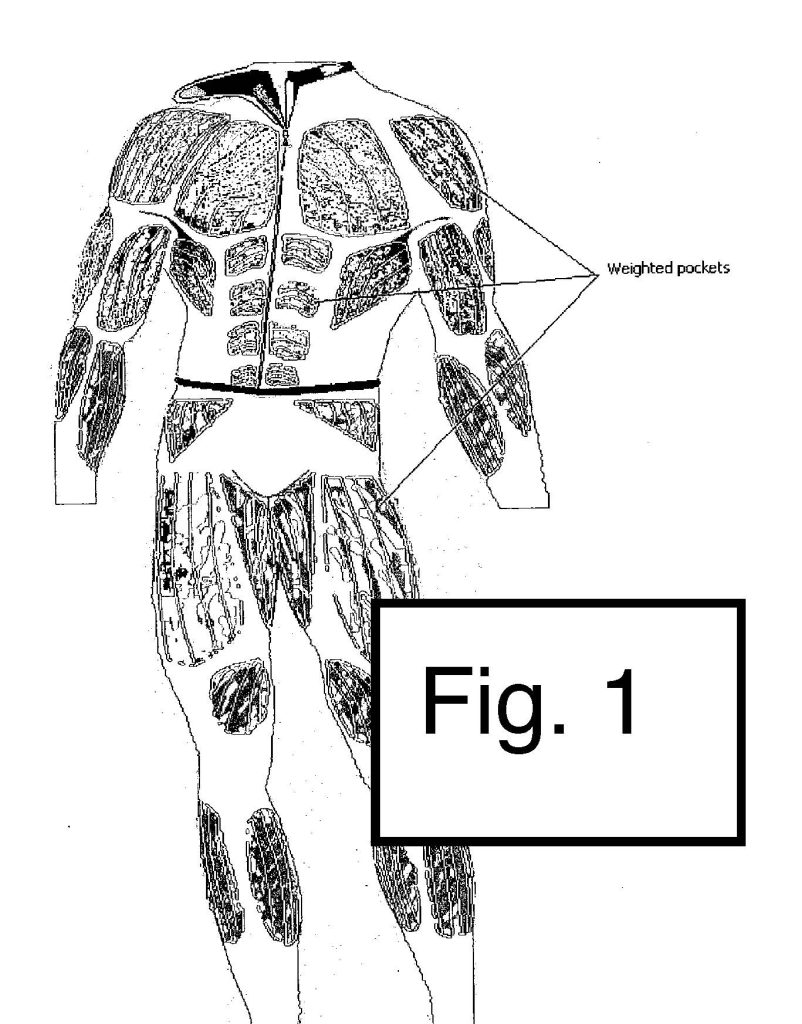As we sit on the beach, trying to avoid the sun, what better time to contemplate swimwear inventions?
Consider the ‘Two Piece Full Body Weighted Swimsuit’ of U.S. Pat. Pub. 2004/0221,355 by Garcia, published November 11, 2004 and shown as fig. 1. It’s a training aid for competitive swimmers. The dark patches are weights, up to 30 lbs (!!!) without neoprene or other flotation. No quick-to-shed diver’s weight belt here. This author thinks of it as the ‘Burial at Sea Suit.’
How about the ‘Transparent Protective Swimsuit Covering Garment,’ or ‘Full Body Condom’ (my term) of U.S. Pat. 6,477,712 to Jones issued November 12, 2002 of fig. 2. This transparent garment allows a swimmer to display his or her swimwear at a public pool without exposure to the pathogens lurking in the pool. This observer notes that the wearer must spend all of his or her time in the water, otherwise the ‘Transparent Protective Swimsuit…’ becomes the Solar Roaster Swimsuit.
Here’s something that holds promise for swimmers – permanent magnets as shark repellant, from U.S. Pat. 9,084,415 to Stroud issued July 21, 2015, shown by fig. 3. The magnetic repellant works by interfering with the shark’s electrical sensors. The downside is that the magnets have a short range (10 inches or so) and that 10 to 20 lbs of magnets would be needed to protect one swimmer, which has not discouraged a lively business in anti-shark bracelets . Even more important than preventing rare shark attacks, magnets in fishing gear actually reduce the very real problem of shark bycatch in commercial fishing.

Staying on our shark theme, U.S. Pat. 7,233,829 to Vlad (fig. 4) is for a wetsuit that generates an electrical field to discourage sharks. The wetsuit generates its own power through movement of the diver without a battery or other power supply. While this author can offer no opinion on the effectiveness of the Vlad generator wetsuit, products that generate electrical fields are somewhat effective in repelling sharks.

We all love to fear sharks, so here’s one more: U.S. Design Pat. D917,129 to Foley, issued April 27, 2021 (fig. 5). Foley, being a design patent, does not describe how the invention is worn or how it works, so those questions are left to our imagination. This author sees two possibilities – first, it’s an armored shell, like a snail shell, into which the swimmer retreats upon the appearance of a shark. Alternatively it’s a sleeve, like the articulating armor worn by a medieval knight. Either way, it will do little to aid the swimmer in moving through the water, to, say, take an occasional breath.

Finally, we have non-shark design patent D547,028 to Mikol issued August 7, 2007 for a swimsuit. The designer liked the design so much that he secured thirteen separate design patents for thirteen separate design variations. Fig. 6 is a sample of four of the thirteen designs. The ‘028 patent is on the left:

Important lessons here on patent law? Hmm. This author will creep further under his beach umbrella and think about it.
— Robert Yarbrough, Esq.



